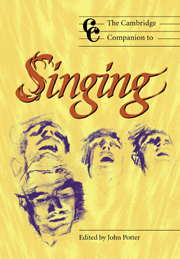Book contents
- Frontmatter
- 1 Introduction: singing at the turn of the century
- Part I Popular traditions
- Part II The voice in the theatre
- Part III Choral music and song
- Part IV Performance practices
- 12 Some notes on choral singing
- 13 Ensemble singing
- 14 The voice in the Middle Ages
- 15 Reconstructing pre-Romantic singing technique
- 16 Alternative voices: contemporary vocal techniques
- 17 The teaching (and learning) of singing
- 18 Children's singing
- 19 Where does the sound come from?
- Notes
- Select bibliography
- Index
15 - Reconstructing pre-Romantic singing technique
from Part IV - Performance practices
Published online by Cambridge University Press: 28 September 2011
- Frontmatter
- 1 Introduction: singing at the turn of the century
- Part I Popular traditions
- Part II The voice in the theatre
- Part III Choral music and song
- Part IV Performance practices
- 12 Some notes on choral singing
- 13 Ensemble singing
- 14 The voice in the Middle Ages
- 15 Reconstructing pre-Romantic singing technique
- 16 Alternative voices: contemporary vocal techniques
- 17 The teaching (and learning) of singing
- 18 Children's singing
- 19 Where does the sound come from?
- Notes
- Select bibliography
- Index
Summary
Considering the tremendous breadth of musical activity throughout Europe and the range of its different social, technical and aesthetic contexts between the beginning of the sixteenth and the end of the eighteenth centuries, the sheer consistency of the information we have about the fundamentals of the art of singing during this time is remarkable. Some aspects of vocal performance which were constantly repeated throughout the period are as obviously necessary now as they were then. For example, the repeated demand that the words always be audibly and correctly pronounced, the text understood and intelligibly delivered by the singer, and that its meaning and poetics inform every aspect of the musical performance, suggests that in former times, just as in the present, singers needed regularly reminding of this fundamental principle. There are other aspects of vocal performance which were also reiterated in every generation, but which nowadays are either little understood and not seen as being as important as they once were (for example, the correct way to articulate passaggi), or which are quite simply not considered any more (for example, the differentiation of chest and falsetto registers and their proper joining together) and are therefore no longer part of the training of professional singers.
What, then, were the main preoccupations of singing teachers, writers of vocal treatises and singers themselves in the centuries under consideration and how might an awareness of the differences from current priorities in the teaching of singing technique affect the choices that performers of pre-nineteenth-century music might yet make, even in the current ‘age of enlightenment’ of historically aware music-making?
- Type
- Chapter
- Information
- The Cambridge Companion to Singing , pp. 178 - 191Publisher: Cambridge University PressPrint publication year: 2000
- 6
- Cited by

